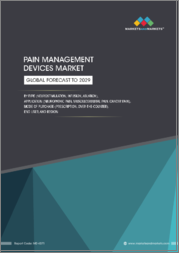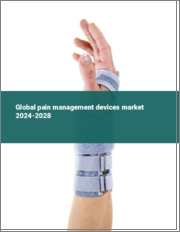
|
시장보고서
상품코드
1702512
세계의 통증 관리 기기 시장 평가 : 제품별, 용도별, 구입 방법별, 최종사용자별, 지역별, 기회 및 예측(2018-2032년)Pain Management Devices Market Assessment, By Product, By Application, By Mode-of-Purchase, By End-user, By Region, Opportunities and Forecast, 2018-2032F |
||||||
세계 통증 관리 기기 시장 규모는 2024년 48억 4,000만 달러에서 2032년에는 88억 2,000만 달러에 달할 것으로 예상되며, 2025-2032년의 예측 기간 동안 연평균 7.80%의 성장률을 보일 것으로 예측됩니다. 시장의 성장과 확대는 암, 관절염, 신경장애와 같은 만성질환 환자 증가로 인한 것으로 추정되며, American Cancer Society의 추정에 따르면 2025년 미국에서 204만 1,910명의 새로운 암 환자가 발생할 것으로 예상됩니다. 노인은 만성통증에 걸리기 쉽고, 다양한 질병과 장애에 걸리기 쉽기 때문에 고령화의 급속한 진행은 통증 관리 기기에 대한 수요를 더욱 증가시키고 있습니다. 또한, 약물 통증 관리 솔루션의 장기간 사용으로 인한 부작용에 대한 인식이 높아짐에 따라 환자 및 의료 서비스 제공업체의 통증 관리 솔루션 채택을 촉진하고 있습니다.
또한, 공동 연구 증가와 제품 개발 활동 증가는 세계 통증 관리 기기 시장의 성장을 가속하고 있습니다. 의료기기 제조업체들은 연구기관과 협력하여 AI, 실시간 모니터링, 클라우드 기반 시스템 등의 요소를 통증 관리 솔루션에 도입하고 있습니다. 이러한 기술 혁신을 통해 환자와 의사는 통증 치료의 성과를 보다 효율적으로 평가할 수 있습니다. 또한, 의료기기 제조업체와 학술 연구 기관과의 파트너십을 통해 환자 집단에서 통증 관리 시스템의 안전성과 유효성을 입증하기 위한 임상시험이 추진되고 있습니다. 이러한 접근 방식은 전 세계 여러 지역에서 규제 당국의 승인을 쉽게 획득할 수 있도록 돕고 있습니다.
세계의 통증 관리 기기 시장에 대해 조사 분석했으며, 시장 규모와 예측, 시장 역학, 주요 기업 개요 등의 정보를 전해드립니다.
목차
제1장 프로젝트의 범위와 정의
제2장 조사 방법
제3장 주요 요약
제4장 세계의 통증 관리 기기 시장 전망(2018년-2032년)
- 시장 규모 분석과 예측
- 금액
- 시장 점유율 분석과 예측
- 제품별
- 용도별
- 구입 방법별
- 최종사용자별
- 지역별
- 시장 점유율 분석 : 기업별(금액)(주요 5개사와 기타 - 2024년)
- 시장 맵 분석(2024년)
- 제품별
- 용도별
- 구입 방법별
- 최종사용자별
- 지역별
제5장 북미의 통증 관리 기기 시장 전망(2018년-2032년)
- 시장 규모 분석과 예측
- 금액
- 시장 점유율 분석과 예측
- 제품별
- 용도별
- 구입 방법별
- 최종사용자별
- 점유율 : 국가별
- 국가별 시장 평가
- 미국의 통증 관리 기기 시장 전망(2018년-2032년)
- 캐나다
- 멕시코
제6장 유럽의 통증 관리 기기 시장 전망(2018년-2032년)
- 독일
- 프랑스
- 이탈리아
- 영국
- 러시아
- 네덜란드
- 스페인
- 튀르키예
- 폴란드
제7장 아시아태평양의 통증 관리 기기 시장 전망(2018년-2032년)
- 인도
- 중국
- 일본
- 호주
- 베트남
- 한국
- 인도네시아
- 필리핀
제8장 남미의 통증 관리 기기 시장 전망(2018년-2032년)
- 브라질
- 아르헨티나
제9장 중동 및 아프리카의 통증 관리 기기 시장 전망(2018년-2032년)
- 사우디아라비아
- 아랍에미리트(UAE)
- 남아프리카공화국
제10장 수급 분석
제11장 수출입 분석
제12장 밸류체인 분석
제13장 Porter의 Five Forces 분석
제14장 PESTLE 분석
제15장 가격 분석
제16장 시장 역학
- 시장 성장 촉진요인
- 시장이 해결해야 할 과제
제17장 시장 동향과 발전
제18장 규제 상황과 혁신
제19장 사례 연구
제20장 경쟁 구도
- 시장 리더 주요 5개사의 경쟁 매트릭스
- 주요 5개사의 SWOT 분석
- 주요 기업 10개사 상황
- B Braun Melsungen AG
- Boston Scientific Corporation
- Nevro Corporation
- Baxter International Inc.
- Medtronic plc
- Stryker Corporation
- Enovis Corporation
- Teleflex Incorporated
- ICU Medical, Inc.
- Stimwave LLC
제21장 전략적 제안
제22장 리서치사에 대해 & 면책사항
LSH 25.04.24Global pain management devices market is projected to witness a CAGR of 7.80% during the forecast period 2025-2032, growing from USD 4.84 billion in 2024 to USD 8.82 billion in 2032. The market's growth and expansion can be attributed to the increasing cases of chronic conditions including cancer, arthritis, and neuropathy. As per the estimates of the American Cancer Society, 2,041,910 new cases of cancer are expected to occur in the United States in 2025. The rapid growth of the aging population is further bolstering the demand for pain management devices as the older population is more prone to chronic pain causing conditions and susceptible to various diseases and disorders. Additionally, increasing awareness about the side effects of using pharmaceutical pain management solutions for long periods of time is also driving patients and healthcare providers to adopt device-based pain management solutions.
Additionally, increasing collaborations and rising efforts towards product development are driving the growth of the global pain management devices market. Medical device companies are joining forces with research institutions to incorporate elements like artificial intelligence (AI), real-time monitoring, and cloud-based systems into pain management solutions. These innovations allow patients and physicians to assess pain therapy outcomes more efficiently. Additionally, partnerships among medical device manufacturers and academic research institutes are also encouraging clinical trials to establish the safety and efficacy of the pain management systems in the patient population. Such an approach is facilitating regulatory approvals across different regions across the globe.
Increasing Prevalence of Chronic Pain Disorders Boosts Market Demand
The growing prevalence of chronic pain disorders such as neuropathic pain, cancer pain, musculoskeletal pain, migraine, facial and dental pain, among others is propelling the reliance on pain management devices. As per the estimates of the American Migraine Foundation, more than one billion people across the globe are living with migraine. The complex neurological disorder is genetically influenced and is usually characterized by severe to moderate headaches accompanied by extreme sensitivity to sound and light and nausea.
Non-opioid based pain relief options are being heavily prioritized by healthcare professionals as part of a global initiative to combat the opioid crisis. Meanwhile, devices, including transcutaneous electrical nerve stimulation (TENS) devices and spinal cord stimulators are gaining popularity due to their long-term efficacy and non-addictive nature. Furthermore, wearable pain relief technologies also allow patients to manage pain from the comfort of their homes, increasing their convenience and thus improving compliance and enhancing patient outcomes.
Technological Innovations Support Market Expansion
Increasing emphasis on development of technologically advanced devices is providing lucrative growth opportunities for the market as they aid in expanding the applicability of pain management to a wider population base, improving the quality of life for the patient population and supporting the growth of the market. Meanwhile, connectivity features along with smart technologies are enabling remote monitoring, data sharing between patients and healthcare professionals, improving treatment outcomes and patient satisfaction, and providing personalized treatment options. Thus, leading medical device companies are focusing on developing new products and technologies.
For instance, in September 2024, Nevro Corporation announced a limited market launch of its HFX iQ with HFX AdaptivAI after receiving approval from the United States Food and Drug Administration (US FDA). HFX AdaptivAI is designed for providing responsive and personalized pain relief. The system's advanced technology uses direct patient input for creating real-time custom therapy programs.
Neuropathic Pain Accounts for Significant Share of the Market
The segment's growth is supported by the rising prevalence of the condition in different regions across the globe, rising focus of medical devices and pharmaceutical companies to provide pain management solutions for such patients, and growing prevalence of lifestyle related disorders. As per the estimates of the British Pain Society, chronic pain affects 30% of the population in Northern Ireland and 13% of the population in the Republic of Ireland.
Meanwhile, cancer pain is expected to witness significant growth in the coming years. The rising cases of cancer in various countries is propelling the requirement for effective pain management solutions for pain caused due to nerve compression, among others. Thus, providing lucrative growth opportunities for the market.
North America Region Holds Major Market Share
The market's dominance in the region can be attributed to the expansion of the geriatric population, high prevalence of chronic and neuropathic diseases, presence of a strong healthcare system and pharma sector, and growing preference for non-opioid based pain management solutions. As per the estimates of the American Migraine Foundation, approximately 39 million people in America suffer from migraine. Additionally, the favorable reimbursement policies in various countries in North America enhance access to pain management devices.
Meanwhile, the market in the Asia-Pacific is expected to witness significant growth over the forecast period due to rapid aging in the region, growing awareness about various neuropathic diseases and the available treatment options, and the increasing investments in healthcare infrastructure.
Future Market Scenario (2025 - 2032F)
The market is expected to witness significant growth in the coming years due to rising preference for home healthcare settings, increasing demand for non-pharmacological solutions for pain management, and rapid integration of digital tools with pain management devices. Additionally, ongoing advancements in medical technologies, including miniaturization and wireless integration, are also creating a promising landscape for the market's future. Meanwhile, the increasing prevalence of various chronic diseases and disorders is also expected to provide lucrative growth opportunities for the market. The American Cancer Society estimates that the number of cases of cancer across the globe will reach 35 million by 2050.
Moreover, different governments and regulatory bodies are showing strong interest in expanding access to safer pain treatments, opening up new funding channels for pain management device manufacturers and approval pathways for novel technologies.
Key Players Landscape and Outlook
The key players of the market are actively working on introducing new products and technologies as well as focusing on receiving approvals from different regulatory bodies in order to ensure that their products are easily available for the patient population. For instance, in April 2024, Medtronic plc received approval from the US FDA for its Inceptiv closed-loop rechargeable spinal cord stimulator (SCS) for treating chronic pain. The product is Medtronic's first SCS device that offers a closed-loop feature that automatically adjusts stimulation in real time and senses biological signals along the spinal cord, ensuring that therapy is in harmony with the activities of daily life, improving patient convenience and treatment compliance. Thus, such product launches are allowing the key players of the market to expand their market presence and increase their revenues.
Table of Contents
1. Project Scope and Definitions
2. Research Methodology
3. Executive Summary
4. Global Pain Management Devices Market Outlook, 2018-2032F
- 4.1. Market Size Analysis & Forecast
- 4.1.1. By Value
- 4.2. Market Share Analysis & Forecast
- 4.2.1. By Product
- 4.2.1.1. Neurostimulation Devices
- 4.2.1.1.1. Spinal Cord Stimulators
- 4.2.1.1.2. Transcutaneous Electrical Nerve Stimulation (TENS) Devices
- 4.2.1.1.3. Others
- 4.2.1.2. Ablation Devices
- 4.2.1.2.1. Radiofrequency Ablation Devices
- 4.2.1.2.2. Cryoablation Devices
- 4.2.1.2.3. Others
- 4.2.1.3. Analgesic Infusion Pumps
- 4.2.1.3.1. Intrathecal Infusion Pumps
- 4.2.1.3.2. External Infusion Pumps
- 4.2.1.1. Neurostimulation Devices
- 4.2.2. By Application
- 4.2.2.1. Neuropathic Pain
- 4.2.2.2. Cancer Pain
- 4.2.2.3. Musculoskeletal Pain
- 4.2.2.4. Migraine
- 4.2.2.5. Facial and Dental Pain
- 4.2.2.6. Others
- 4.2.3. By Mode-of-Purchase
- 4.2.3.1. Prescription-Based
- 4.2.3.2. Over-the-Counter (OTC)
- 4.2.4. By End-user
- 4.2.4.1. Hospitals and Clinics
- 4.2.4.2. Ambulatory Surgical Centers
- 4.2.4.3. Home Healthcare
- 4.2.4.4. Others
- 4.2.5. By Region
- 4.2.5.1. North America
- 4.2.5.2. Europe
- 4.2.5.3. Asia-Pacific
- 4.2.5.4. South America
- 4.2.5.5. Middle East and Africa
- 4.2.6. By Company Market Share Analysis (Top 5 Companies and Others - By Value, 2024)
- 4.2.1. By Product
- 4.3. Market Map Analysis, 2024
- 4.3.1. By Product
- 4.3.2. By Application
- 4.3.3. By Mode-of-Purchase
- 4.3.4. By End-user
- 4.3.5. By Region
5. North America Pain Management Devices Market Outlook, 2018-2032F
- 5.1. Market Size Analysis & Forecast
- 5.1.1. By Value
- 5.2. Market Share Analysis & Forecast
- 5.2.1. By Product
- 5.2.1.1. Neurostimulation Devices
- 5.2.1.1.1. Spinal Cord Stimulators
- 5.2.1.1.2. Transcutaneous Electrical Nerve Stimulation (TENS) Devices
- 5.2.1.1.3. Others
- 5.2.1.2. Ablation Devices
- 5.2.1.2.1. Radiofrequency Ablation Devices
- 5.2.1.2.2. Cryoablation Devices
- 5.2.1.2.3. Others
- 5.2.1.3. Analgesic Infusion Pumps
- 5.2.1.3.1. Intrathecal Infusion Pumps
- 5.2.1.3.2. External Infusion Pumps
- 5.2.1.1. Neurostimulation Devices
- 5.2.2. By Application
- 5.2.2.1. Neuropathic Pain
- 5.2.2.2. Cancer Pain
- 5.2.2.3. Musculoskeletal Pain
- 5.2.2.4. Migraine
- 5.2.2.5. Facial and Dental Pain
- 5.2.2.6. Others
- 5.2.3. By Mode-of-Purchase
- 5.2.3.1. Prescription-Based
- 5.2.3.2. Over-the-Counter (OTC)
- 5.2.4. By End-user
- 5.2.4.1. Hospitals and Clinics
- 5.2.4.2. Ambulatory Surgical Centers
- 5.2.4.3. Home Healthcare
- 5.2.4.4. Others
- 5.2.5. By Country Share
- 5.2.5.1. United States
- 5.2.5.2. Canada
- 5.2.5.3. Mexico
- 5.2.1. By Product
- 5.3. Country Market Assessment
- 5.3.1. United States Pain Management Devices Market Outlook, 2018-2032F*
- 5.3.1.1. Market Size Analysis & Forecast
- 5.3.1.1.1. By Value
- 5.3.1.2. Market Share Analysis & Forecast
- 5.3.1.2.1. By Product
- 5.3.1.2.1.1. Neurostimulation Devices
- 5.3.1.2.1.1.1. Spinal Cord Stimulators
- 5.3.1.2.1.1.2. Transcutaneous Electrical Nerve Stimulation (TENS) Devices
- 5.3.1.2.1.1.3. Others
- 5.3.1.2.1.2. Ablation Devices
- 5.3.1.2.1.2.1. Radiofrequency Ablation Devices
- 5.3.1.2.1.2.2. Cryoablation Devices
- 5.3.1.2.1.2.3. Others
- 5.3.1.2.1.3. Analgesic Infusion Pumps
- 5.3.1.2.1.3.1. Intrathecal Infusion Pumps
- 5.3.1.2.1.3.2. External Infusion Pumps
- 5.3.1.2.2. By Application
- 5.3.1.2.2.1. Neuropathic Pain
- 5.3.1.2.2.2. Cancer Pain
- 5.3.1.2.2.3. Musculoskeletal Pain
- 5.3.1.2.2.4. Migraine
- 5.3.1.2.2.5. Facial and Dental Pain
- 5.3.1.2.2.6. Others
- 5.3.1.2.3. By Mode-of-Purchase
- 5.3.1.2.3.1. Prescription-Based
- 5.3.1.2.3.2. Over-the-Counter (OTC)
- 5.3.1.2.4. By End-user
- 5.3.1.2.4.1. Hospitals and Clinics
- 5.3.1.2.4.2. Ambulatory Surgical Centers
- 5.3.1.2.4.3. Home Healthcare
- 5.3.1.2.4.4. Others
- 5.3.1.2.1. By Product
- 5.3.1.1. Market Size Analysis & Forecast
- 5.3.2. Canada
- 5.3.3. Mexico
- 5.3.1. United States Pain Management Devices Market Outlook, 2018-2032F*
All segments will be provided for all regions and countries covered
6. Europe Pain Management Devices Market Outlook, 2018-2032F
- 6.1. Germany
- 6.2. France
- 6.3. Italy
- 6.4. United Kingdom
- 6.5. Russia
- 6.6. Netherlands
- 6.7. Spain
- 6.8. Turkey
- 6.9. Poland
7. Asia-Pacific Pain Management Devices Market Outlook, 2018-2032F
- 7.1. India
- 7.2. China
- 7.3. Japan
- 7.4. Australia
- 7.5. Vietnam
- 7.6. South Korea
- 7.7. Indonesia
- 7.8. Philippines
8. South America Pain Management Devices Market Outlook, 2018-2032F
- 8.1. Brazil
- 8.2. Argentina
9. Middle East and Africa Pain Management Devices Market Outlook, 2018-2032F
- 9.1. Saudi Arabia
- 9.2. UAE
- 9.3. South Africa
10. Demand Supply Analysis
11. Import and Export Analysis
12. Value Chain Analysis
13. Porter's Five Forces Analysis
14. PESTLE Analysis
15. Pricing Analysis
16. Market Dynamics
- 16.1. Market Drivers
- 16.2. Market Challenges
17. Market Trends and Developments
18. Regulatory Landscape and Innovation
19. Case Studies
20. Competitive Landscape
- 20.1. Competition Matrix of Top 5 Market Leaders
- 20.2. SWOT Analysis for Top 5 Players
- 20.3. Key Players Landscape for Top 10 Market Players
- 20.3.1. B Braun Melsungen AG
- 20.3.1.1. Company Details
- 20.3.1.2. Key Management Personnel
- 20.3.1.3. Products and Services
- 20.3.1.4. Financials (As Reported)
- 20.3.1.5. Key Market Focus and Geographical Presence
- 20.3.1.6. Recent Developments/Collaborations/Partnerships/Mergers and Acquisition
- 20.3.2. Boston Scientific Corporation
- 20.3.3. Nevro Corporation
- 20.3.4. Baxter International Inc.
- 20.3.5. Medtronic plc
- 20.3.6. Stryker Corporation
- 20.3.7. Enovis Corporation
- 20.3.8. Teleflex Incorporated
- 20.3.9. ICU Medical, Inc.
- 20.3.10. Stimwave LLC
- 20.3.1. B Braun Melsungen AG
Companies mentioned above DO NOT hold any order as per market share and can be changed as per information available during research work.



















